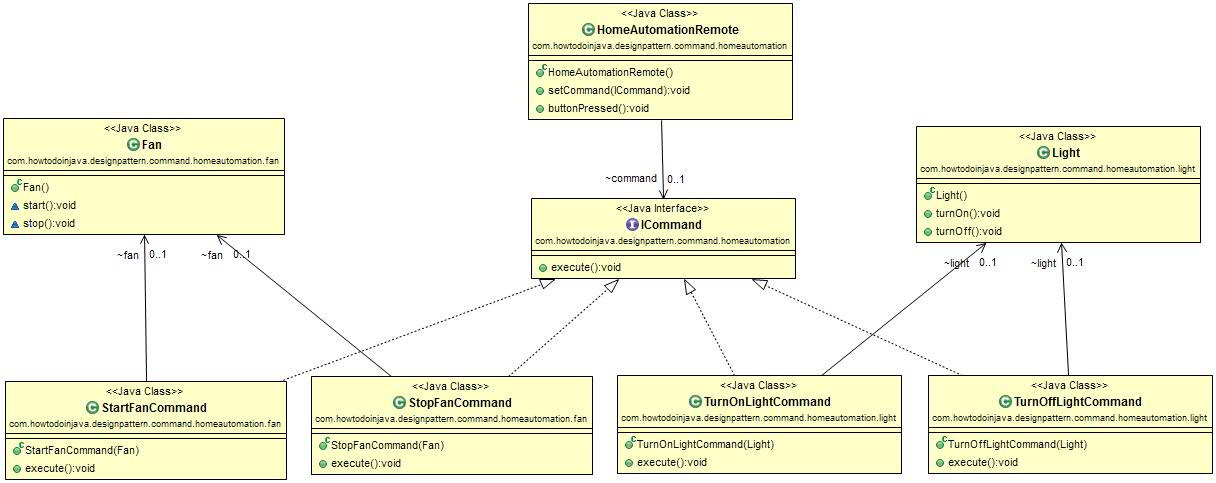原文: https://howtodoinjava.com/design-patterns/behavioral/command-pattern/
命令模式是一种行为型设计模式,可用于将业务逻辑抽象为离散的动作,我们将其称为命令。 此命令对象有助于松散耦合两个类之间的关系,其中一个类(调用者)应调用另一类(接收者)上的方法来执行业务操作。
让我们学习命令如何帮助将调用者与接收者解耦。
Table of ContentsIntroductionDesign ParticipantsProblem StatementCommand Pattern ImplementationDemoWhen to Use Command PatternPopular ImplementationsSummary
介绍
在面向对象的编程中,命令模式是一种行为型设计模式,其中一个对象用于封装执行动作,业务操作或触发事件所需的所有信息。 方法名称,接收方对象引用和方法参数值(如果有)。 该对象称为命令。
类似的方法也适用于责任链模式。 唯一的区别是命令中只有一个请求处理器,而在责任链中单个请求对象可以有许多处理器。
设计参与者
命令设计模式的参与者包括:
- 命令接口 – 用于声明操作。
- 具体命令类 – 扩展了
Command接口,并具有用于在接收方上调用业务操作方法的执行方法。 它在内部具有命令接收者的参考。 - 调用者 – 被赋予执行操作的命令对象。
- 接收器 – 执行操作。
在命令模式中,调用者与接收者执行的动作分离。 调用者不知道接收者。 调用者调用一个命令,然后该命令执行接收方的相应操作。 因此,调用者可以在不知道要执行的动作的细节的情况下调用命令。 此外,这种脱钩意味着对接收者动作的更改不会直接影响动作的调用。
问题陈述
假设我们需要为家庭自动化系统构建一个遥控器,该遥控器应控制房屋的不同照明/电气单元。 遥控器中的单个按钮可能能够在类似设备上执行相同的操作,例如,电视开/关按钮可用于打开/关闭不同房间中的不同电视机。
在这里,此遥控器将是一个可编程的遥控器,它将用于打开和关闭各种灯/风扇等。
首先,让我们看看如何使用任何设计方法解决问题。 她的遥控器代码可能看起来像:
If(buttonName.equals(“Light”)){//Logic to turn on that light}else If(buttonName.equals(“Fan”)){//Logic to turn on that Fan}
但是上述解决方案显然存在许多明显的问题,例如:
- 任何新项目(例如
TubeLight)都需要更改遥控器的代码。 您将需要添加更多的if-else。 - 如果我们想为其他目的更改按钮,那么我们也需要更改代码。
- 最重要的是,如果家里有很多项目,代码的复杂性和可维护性将会增加。
- 最后,代码不干净且紧密耦合,我们未遵循为接口编码等最佳实践。
命令模式实现
让我们用命令设计模式解决上述家庭自动化问题,并一次设计一个组件。
ICommand接口是命令接口Light是接收器组件之一。 它可以接受与Light有关的多个命令,例如打开和关闭Fan也是接收器组件的另一种类型。 它可以接受与风扇相关的多个命令,例如打开和关闭HomeAutomationRemote是调用者对象,它要求命令执行请求。 这里风扇开/关,灯开/关。StartFanCommand,StopFanCommand,TurnOffLightCommand,TurnOnLightCommand等是命令实现的不同类型。
类图

命令模式类图
让我们看一下每个类和接口的 java 源代码。
ICommand.java
package com.howtodoinjava.designpattern.command.homeautomation;/*** Command Interface which will be implemented by the exact commands.**/@FunctionalInterfacepublic interface ICommand {public void execute();}
Light.java
package com.howtodoinjava.designpattern.command.homeautomation.light;/*** Light is a Receiver component in command pattern terminology.**/public class Light {public void turnOn() {System.out.println("Light is on");}public void turnOff() {System.out.println("Light is off");}}
Fan.java
package com.howtodoinjava.designpattern.command.homeautomation.fan;/*** Fan class is a Receiver component in command pattern terminology.**/public class Fan {void start() {System.out.println("Fan Started..");}void stop() {System.out.println("Fan stopped..");}}
TurnOffLightCommand.java
package com.howtodoinjava.designpattern.command.homeautomation.light;import com.howtodoinjava.designpattern.command.homeautomation.ICommand;/*** Light Start Command where we are encapsulating both Object[light] and the* operation[turnOn] together as command. This is the essence of the command.**/public class TurnOffLightCommand implements ICommand {Light light;public TurnOffLightCommand(Light light) {super();this.light = light;}public void execute() {System.out.println("Turning off light.");light.turnOff();}}
TurnOnLightCommand.java
package com.howtodoinjava.designpattern.command.homeautomation.light;import com.howtodoinjava.designpattern.command.homeautomation.ICommand;/*** Light stop Command where we are encapsulating both Object[light] and the* operation[turnOff] together as command. This is the essence of the command.**/public class TurnOnLightCommand implements ICommand {Light light;public TurnOnLightCommand(Light light) {super();this.light = light;}public void execute() {System.out.println("Turning on light.");light.turnOn();}}
StartFanCommand.java
package com.howtodoinjava.designpattern.command.homeautomation.fan;import com.howtodoinjava.designpattern.command.homeautomation.ICommand;/*** Fan Start Command where we are encapsulating both Object[fan] and the* operation[start] together as command. This is the essence of the command.**/public class StartFanCommand implements ICommand {Fan fan;public StartFanCommand(Fan fan) {super();this.fan = fan;}public void execute() {System.out.println("starting Fan.");fan.start();}}
StopFanCommand.java
package com.howtodoinjava.designpattern.command.homeautomation.fan;import com.howtodoinjava.designpattern.command.homeautomation.ICommand;/*** Fan stop Command where we are encapsulating both Object[fan] and the* operation[stop] together as command. This is the essence of the command.**/public class StopFanCommand implements ICommand {Fan fan;public StopFanCommand(Fan fan) {super();this.fan = fan;}public void execute() {System.out.println("stopping Fan.");fan.stop();}}
HomeAutomationRemote.java
package com.howtodoinjava.designpattern.command.homeautomation;/*** Remote Control for Home automation where it will accept the command and* execute. This is the invoker in terms of command pattern terminology*/public class HomeAutomationRemote {//Command HolderICommand command;//Set the command in runtime to trigger.public void setCommand(ICommand command) {this.command = command;}//Will call the command interface method so that particular command can be invoked.public void buttonPressed() {command.execute();}}
演示
让我们编写代码并执行客户端代码,以查看命令的执行方式。
package com.howtodoinjava.designpattern.command.homeautomation;import com.howtodoinjava.designpattern.command.homeautomation.fan.Fan;import com.howtodoinjava.designpattern.command.homeautomation.fan.StartFanCommand;import com.howtodoinjava.designpattern.command.homeautomation.fan.StopFanCommand;import com.howtodoinjava.designpattern.command.homeautomation.light.Light;import com.howtodoinjava.designpattern.command.homeautomation.light.TurnOnLightCommand;/*** Demo class for HomeAutomation**/public class Demo //client{public static void main(String[] args){Light livingRoomLight = new Light(); //receiver 1Fan livingRoomFan = new Fan(); //receiver 2Light bedRoomLight = new Light(); //receiver 3Fan bedRoomFan = new Fan(); //receiver 4HomeAutomationRemote remote = new HomeAutomationRemote(); //Invokerremote.setCommand(new TurnOnLightCommand( livingRoomLight ));remote.buttonPressed();remote.setCommand(new TurnOnLightCommand( bedRoomLight ));remote.buttonPressed();remote.setCommand(new StartFanCommand( livingRoomFan ));remote.buttonPressed();remote.setCommand(new StopFanCommand( livingRoomFan ));remote.buttonPressed();remote.setCommand(new StartFanCommand( bedRoomFan ));remote.buttonPressed();remote.setCommand(new StopFanCommand( bedRoomFan ));remote.buttonPressed();}}
输出:
Turning on light.Light is onTurning on light.Light is onstarting Fan.Fan Started..stopping Fan.Fan stopped..starting Fan.Fan Started..stopping Fan.Fan stopped..
何时使用命令模式
您可以使用命令模式来解决许多设计问题,例如:
- 处理 Java 菜单项和按钮的动作。
- 提供对宏的支持(宏的记录和播放)。
- 提供“撤消”支持。
- 进度条实现。
- 创建多步骤向导。
流行的命令模式实现
这些是命令模式实现的一些实际示例:
- 可运行接口(
java.lang.Runnable) - Swing
Action(javax.swing.Action)使用命令模式 ActionServlet调用 StrutsAction类在内部使用命令模式。
总结
- 命令模式是一种行为型设计模式。
- 在命令模式中,对象用于封装在任何时间执行操作或触发事件所需的所有信息,从而使开发人员能够分散业务逻辑。 它称为命令。
- 客户端与调用者对话并传递命令对象。
- 每个命令对象都有对其接收者的引用。
Command的execute()方法调用接收器中定义的实际业务操作。- 接收者执行业务操作。
这是此模式的一些利弊。 它可以帮助您就使用命令模式做出正确的决定。
优点
- 使我们的代码具有可伸缩性,因为我们可以添加新命令而无需更改现有代码。
- 使用命令对象增加调用者和接收者之间的松散耦合。
缺点
- 在不同的视图中,增加每个单独命令的类数。 在某些特定情况下,它可能不是首选。
这就是命令设计模式的全部。 将我的问题放在评论部分。
学习愉快!

